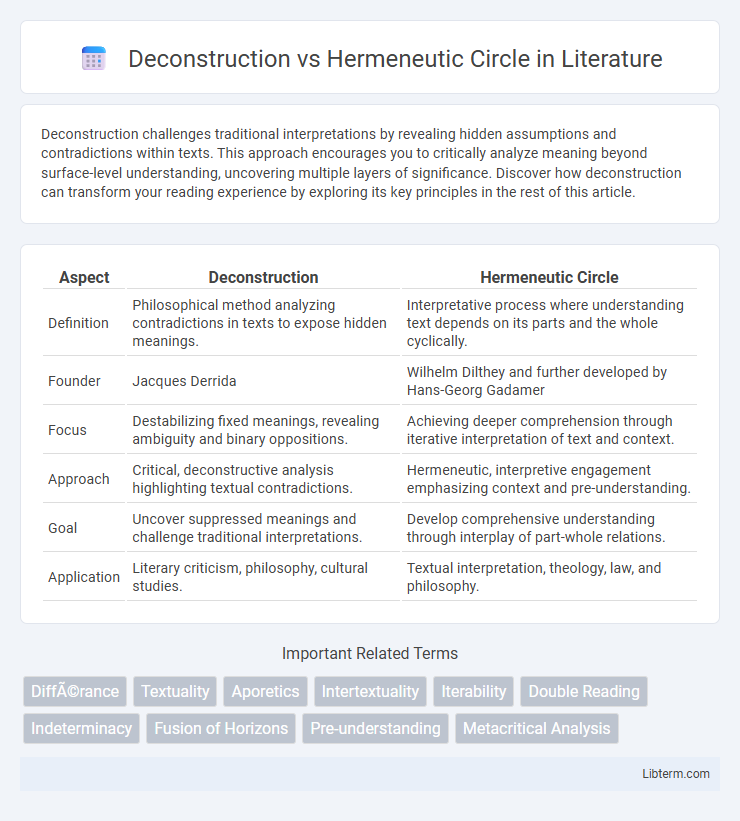Deconstruction challenges traditional interpretations by revealing hidden assumptions and contradictions within texts. This approach encourages you to critically analyze meaning beyond surface-level understanding, uncovering multiple layers of significance. Discover how deconstruction can transform your reading experience by exploring its key principles in the rest of this article.
Table of Comparison
| Aspect | Deconstruction | Hermeneutic Circle |
|---|---|---|
| Definition | Philosophical method analyzing contradictions in texts to expose hidden meanings. | Interpretative process where understanding text depends on its parts and the whole cyclically. |
| Founder | Jacques Derrida | Wilhelm Dilthey and further developed by Hans-Georg Gadamer |
| Focus | Destabilizing fixed meanings, revealing ambiguity and binary oppositions. | Achieving deeper comprehension through iterative interpretation of text and context. |
| Approach | Critical, deconstructive analysis highlighting textual contradictions. | Hermeneutic, interpretive engagement emphasizing context and pre-understanding. |
| Goal | Uncover suppressed meanings and challenge traditional interpretations. | Develop comprehensive understanding through interplay of part-whole relations. |
| Application | Literary criticism, philosophy, cultural studies. | Textual interpretation, theology, law, and philosophy. |
Introduction to Deconstruction and Hermeneutic Circle
Deconstruction, founded by Jacques Derrida, challenges the idea of fixed meanings by exposing inherent contradictions and ambiguities within texts, emphasizing the fluidity of language and interpretation. The Hermeneutic Circle, rooted in philosophical hermeneutics by thinkers like Hans-Georg Gadamer, describes the process of understanding a text by continuously moving between the whole and its parts, acknowledging that interpretation evolves through this dynamic interaction. Both concepts redefine traditional approaches to textual analysis, highlighting the complexity and multiplicity of meaning.
Historical Origins and Philosophical Foundations
Deconstruction, rooted in Jacques Derrida's 1960s philosophy, challenges traditional structures of meaning by exposing inherent contradictions in texts, emphasizing instability and indeterminacy. The Hermeneutic Circle, originating from Wilhelm Dilthey and expanded by Hans-Georg Gadamer and Martin Heidegger, is grounded in phenomenology and focuses on the dynamic interaction between the parts and whole in interpretive understanding. Both approaches fundamentally reshape epistemological assumptions but diverge in methodology, with deconstruction de-centering authorial intent and the Hermeneutic Circle emphasizing historical context and pre-understanding.
Key Thinkers and Influences
Jacques Derrida is the key thinker behind Deconstruction, emphasizing the inherent instability of language and meaning, while Martin Heidegger and Hans-Georg Gadamer significantly influenced the Hermeneutic Circle by focusing on interpretation as a dynamic, cyclical process. Derrida's work challenges traditional structures of thought by revealing contradictions within texts, whereas Gadamer's hermeneutics stresses the fusion of horizons between the interpreter and the text. Both approaches deeply impact contemporary philosophy, literary theory, and critical theory by reshaping how meaning and understanding are approached.
Core Principles of Deconstruction
Deconstruction, pioneered by Jacques Derrida, challenges the fixed meanings of texts by exposing inherent contradictions and binary oppositions within language, emphasizing the instability and multiplicity of interpretation. Unlike the hermeneutic circle, which focuses on understanding a text through the interplay between parts and whole to achieve coherent meaning, deconstruction reveals the fluid and often conflicting layers of meaning that resist final interpretation. Core principles of deconstruction include differance, the endless deferral of meaning, and the critique of logocentrism, highlighting how texts undermine their own claims to truth.
Hermeneutic Circle: Concepts and Mechanisms
The Hermeneutic Circle is a fundamental concept in interpretive theory, describing the iterative process where understanding of the whole text is established through the comprehension of its individual parts, and vice versa. This circular relationship emphasizes the dynamic interaction between the reader's preconceptions and the evolving interpretation, highlighting context and prior knowledge as key mechanisms. Unlike deconstruction, which seeks to unravel inherent contradictions and ambiguities in text, the Hermeneutic Circle prioritizes meaning construction through continuous, reflective engagement with the text's components.
Methodological Approaches Compared
Deconstruction dissects texts to reveal contradictions and instability in meaning, emphasizing the multiplicity of interpretations beyond fixed understanding. The Hermeneutic Circle, by contrast, involves a cyclical methodological approach where understanding emerges through the interplay between the parts of a text and the whole context. Both approaches focus on interpretation but differ as deconstruction challenges the idea of a stable meaning while the Hermeneutic Circle seeks to progressively refine comprehension through iterative analysis.
Language, Text, and Meaning
Deconstruction challenges the stability of meaning in language by exposing inherent contradictions and ambiguities within a text, revealing multiple interpretations rather than a fixed essence. The Hermeneutic Circle emphasizes the dynamic relationship between the parts and the whole of a text, suggesting that understanding evolves through continuous interpretation influenced by context and prior knowledge. Both approaches highlight the complexity of meaning-making, with deconstruction destabilizing textual authority while the Hermeneutic Circle underscores interpretative depth and context in language comprehension.
Critiques and Debates: Deconstruction vs Hermeneutics
Deconstruction faces critiques for its radical skepticism and tendency to destabilize meaning, which some argue renders interpretation endlessly deferred and subjective. Hermeneutics, emphasizing the hermeneutic circle, is debated for its circular reasoning and potential bias in interpreting texts through pre-existing frameworks. The ongoing debate centers on whether texts possess inherent meaning (hermeneutics) or if meaning is perpetually unattainable and fragmented (deconstruction).
Applications in Literary and Philosophical Analysis
Deconstruction challenges traditional interpretations by exposing inherent contradictions and ambiguities within texts, revealing multiple layers of meaning and undermining fixed interpretations in literary and philosophical analysis. The Hermeneutic Circle emphasizes the interdependence between the whole text and its parts, guiding readers through iterative understanding to uncover deeper meanings in complex narratives and philosophical arguments. Both methods enrich critical analysis by encouraging dynamic interpretation, with deconstruction unraveling textual instability and the Hermeneutic Circle fostering holistic comprehension.
Conclusion: Implications for Interpretation
Deconstruction challenges traditional interpretation by exposing inherent contradictions and ambiguities, emphasizing the instability of meaning within texts. The Hermeneutic Circle underscores the iterative process between understanding parts and the whole, promoting a dynamic but coherent interpretation. Together, these approaches highlight that interpretation is both fluid and context-dependent, requiring constant re-evaluation of meaning rather than fixed conclusions.
Deconstruction Infographic

 libterm.com
libterm.com